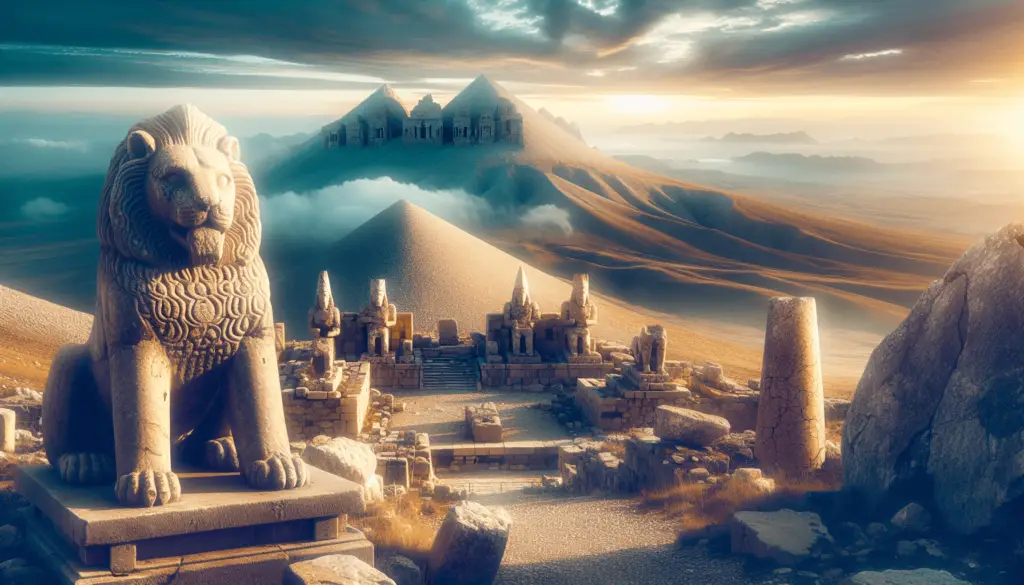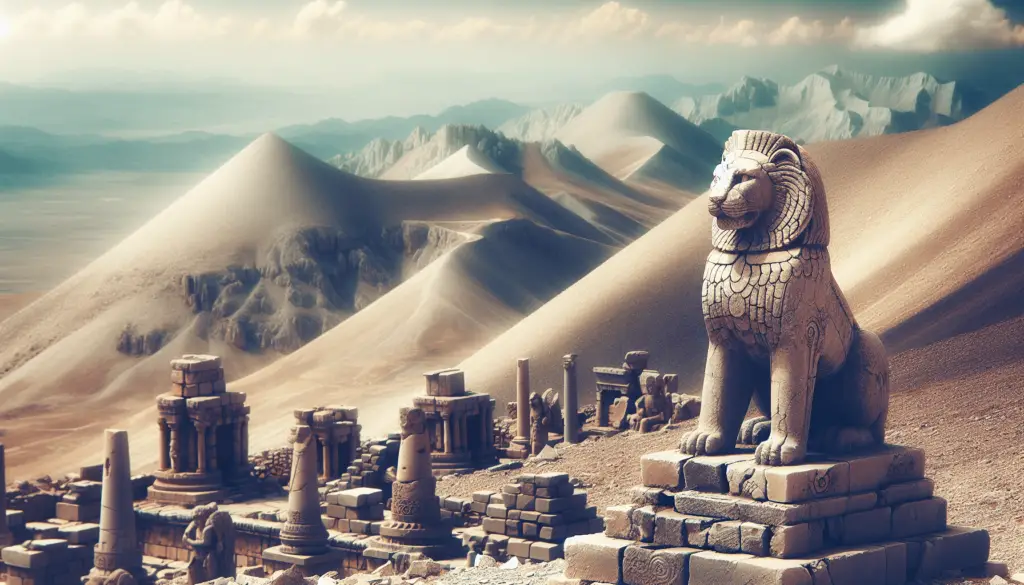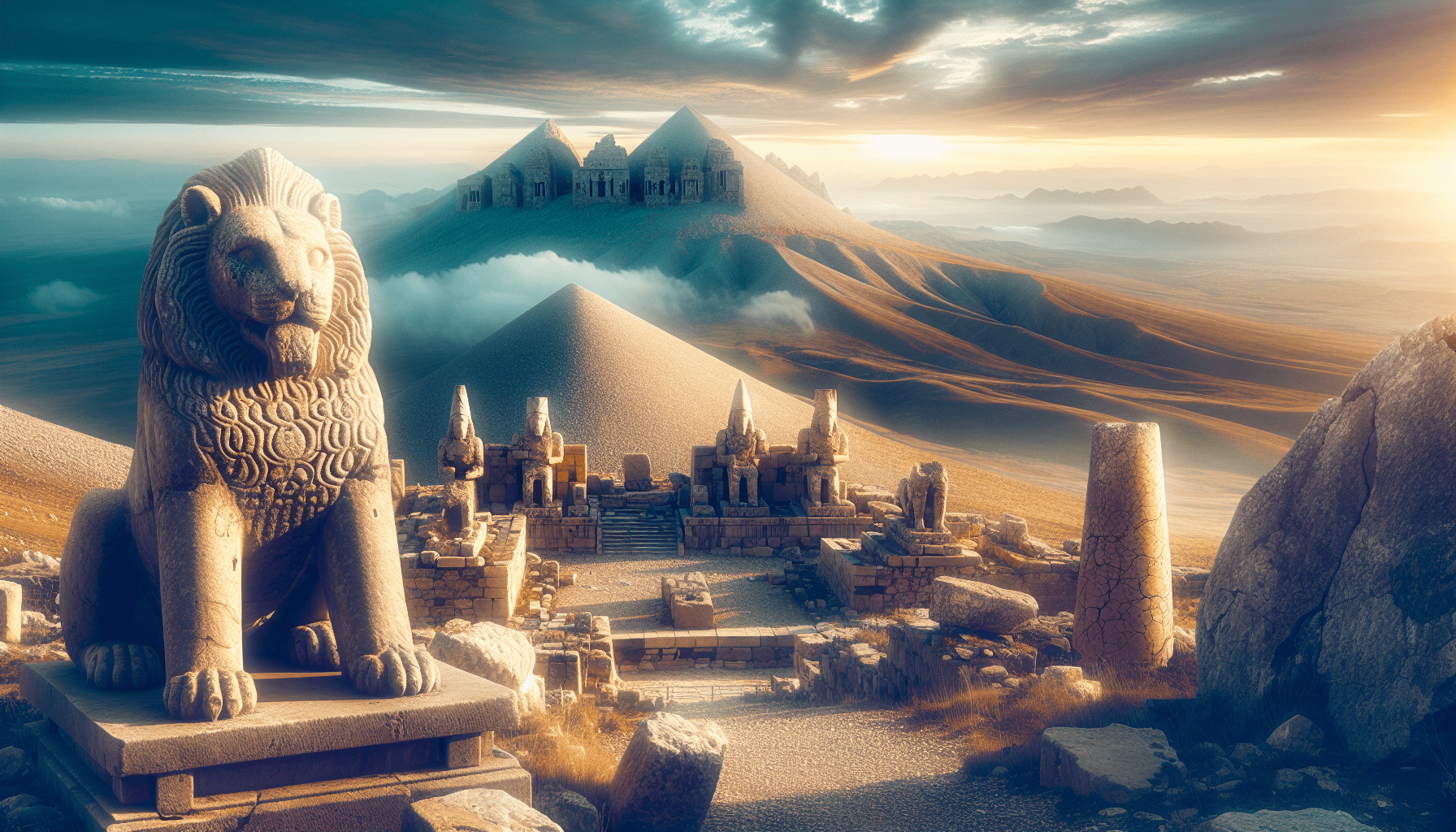Imagine standing at the peak of Mount Nemrut, surrounded by ancient statues and remnants of a bygone era. The majestic Mount Nemrut, located in southeastern Turkey, holds a rich history and is home to some of the most remarkable archaeological sites in the world. This captivating site is not only a testament to the grandeur of a long-lost civilization but also serves as a symbol of religious worship. Join us as we explore the sacred sites of Mount Nemrut and unravel the secrets of its mystical past.

Introduction
Overview of Mount Nemrut
Mount Nemrut, located in southeastern Turkey, is an extraordinary archaeological site that attracts visitors from around the world. This majestic mountain stands at an impressive height of 7,001 feet (2,134 meters) and is known for its awe-inspiring giant statues, ancient ruins, and breathtaking natural beauty. As you make your way up this historical mountain, you will be enchanted by the rich history, cultural significance, and religious importance that surrounds Mount Nemrut.
Significance of Sacred Sites
Sacred sites hold a special place in human history and culture, serving as centers of religious worship, pilgrimage, and cultural significance. These sites often embody the beliefs, values, and traditions of ancient civilizations, allowing us to gain insight into the past and understand the ways in which people communed with the divine. Mount Nemrut is one such sacred site, steeped in history and mythology, and revered for its religious and cultural importance. It offers a unique opportunity to connect with the spiritual practices of ancient civilizations and appreciate the wonders of human ingenuity.
History of Mount Nemrut
Ancient Kingdom of Commagene
The history of Mount Nemrut is closely intertwined with the ancient Kingdom of Commagene, which flourished in the region from the 1st century BC to the 1st century AD. This kingdom was ruled by the enigmatic King Antiochus I, who sought to create a unique fusion of Greek and Persian cultures. This blending of different civilizations is evident in the archaeological sites scattered throughout the region, including the mausoleum and statues atop Mount Nemrut.
Construction of the Mausoleum and Statues
During his reign, King Antiochus I constructed an imposing mausoleum at the summit of Mount Nemrut as a testament to his grandeur and divinity. The mausoleum was adorned with colossal statues, including those of the king himself, various Greek and Persian gods, and a large lion. The construction of these monumental statues required immense skill and labor, showcasing the engineering prowess of the ancient Commagenian civilization.
Abandonment and Rediscovery
Following the death of King Antiochus I, the Kingdom of Commagene gradually declined, and the mausoleum atop Mount Nemrut was abandoned. Over the centuries, the site fell into obscurity and was eventually engulfed by the natural elements. It was not until the 19th century that Mount Nemrut was rediscovered by European travelers, setting in motion a series of archaeological excavations that brought this magnificent site back into the spotlight.
The Mausoleum of Antiochus I
Description of the Mausoleum
The mausoleum atop Mount Nemrut is a remarkable testament to the grandeur and artistic achievements of the ancient Commagenian civilization. The structure, built from massive stone blocks, consists of a central burial chamber and two terraces adorned with statues. The statues, now mostly decapitated, once depicted King Antiochus I, various gods, and celestial figures. Despite their weathered appearance, the remains of these statues showcase the extraordinary level of craftsmanship and attention to detail of the ancient artisans.
Architectural Features
In addition to the statues, the mausoleum also boasts intricate relief carvings, inscriptions, and an arched entrance guarded by massive lion statues. The placement of these statues and reliefs reflects the complex cosmology and religious beliefs of the ancient Commagenians. The architecture of the mausoleum is a unique blend of Greek, Persian, and local traditions, symbolizing the diverse cultural influences that shaped the Kingdom of Commagene.
Importance of the Mausoleum as a Sacred Site
The mausoleum atop Mount Nemrut holds immense religious and cultural significance. It served as a sacred site where the deceased King Antiochus I was believed to communicate with the gods and achieve a divine status. The statues and reliefs not only served as symbols of royal power but also acted as conduits for religious rituals and astronomical observations. As you explore the mausoleum, you will witness the convergence of awe-inspiring architecture and spiritual devotion, encapsulating the essence of this sacred site.
The Giant Statues
Overview of the Giant Statues
Perhaps the most captivating feature of Mount Nemrut is the presence of colossal statues scattered across its summit. These massive stone figures, measuring up to 33 feet (10 meters) in height, were carefully constructed by ancient artisans and meticulously placed to honor both earthly and celestial deities. The giant statues are a testament to the ambitious vision and artistic skill of the Kingdom of Commagene.
Composition and Location
The giant statues atop Mount Nemrut were primarily composed of limestone, an abundant material found in the surrounding region. Each statue represents a specific deity or individual associated with the Kingdom of Commagene, including Greek gods such as Zeus, Apollo, and Hermes, as well as Persian gods like Mithras. These statues were placed on large terraces facing east and west, aligning them with the rising and setting sun.
Symbolism and Meaning
The giant statues at Mount Nemrut hold profound symbolic significance. They embody the blending of different mythologies, cultures, and political ideologies that defined the Kingdom of Commagene. The statues also served as a way for King Antiochus I to project his power and connect himself with both the gods and his ancestors. The positioning of the statues in relation to the sun has led to interpretations of Mount Nemrut as an astronomical observatory, where ancient rituals and celestial observations took place.
Controversies and Restoration Efforts
Over time, the giant statues at Mount Nemrut have faced numerous challenges, including weathering, erosion, and vandalism. The decapitated heads of the statues lying at their feet add an air of mystery and intrigue, as scholars debate the reasons behind their removal. Efforts to restore and preserve these magnificent statues have been ongoing, with various conservation projects and partnerships working towards their protection. These restoration endeavors ensure that future generations can continue to marvel at the splendor of these ancient works of art.

Sunrise and Sunset at Mount Nemrut
Natural Beauty of Mount Nemrut
In addition to its historical and archaeological significance, Mount Nemrut is renowned for its breathtaking natural beauty. The mountain provides a picturesque backdrop, with its rugged peaks, lush greenery, and panoramic views. As you ascend Mount Nemrut, you will be captivated by the serene tranquility of the surrounding landscape and the tranquil silence that envelopes the site, heightening the sense of spirituality and wonder.
Importance of Sunrise and Sunset
Witnessing a sunrise or sunset from the summit of Mount Nemrut is an experience like no other. The sun aligns perfectly with the giant statues, casting ethereal shadows and creating a mesmerizing spectacle. The changing colors of the sky, coupled with the mystical ambiance of the ancient ruins, evokes a sense of awe and introspection. The significance of sunrise and sunset at Mount Nemrut cannot be overstated, as it embodies the connection between the heavens and the earth, and the cyclical nature of life and existence.
Tourist Experiences and Recommendations
To make the most of your visit to Mount Nemrut, it is highly recommended to arrive before sunrise or stay until sunset. This will allow you to witness the stunning interplay of light and shadow, as the statues are bathed in golden hues. It is advisable to dress warmly, as temperatures can be chilly at the summit. Additionally, bringing a camera to capture the magical moments is a must. Whether you choose to hike or take a guided tour, the experience of witnessing sunrise or sunset at Mount Nemrut will leave an indelible imprint on your memory.
Religious and Cultural Significance
Commagene Religion
The Kingdom of Commagene had a unique religious system that blended aspects of Greek, Persian, and local beliefs. At the core of their religious practice was the veneration of deified rulers, with Mount Nemrut serving as a sacred site for these rituals. The kingdom believed in the divine status of their rulers, who were worshipped as intermediaries between the gods and the people. Mount Nemrut played a pivotal role in these religious ceremonies, reflecting the significance of the site in the Commagenian belief system.
Influence of Greek and Persian Cultures
The religious and cultural practices of the Kingdom of Commagene were heavily influenced by Greek and Persian civilizations. This fusion is evident in the deities represented in the statues atop Mount Nemrut, with Greek gods often depicted alongside Persian gods associated with the Zoroastrian tradition. The blending of these religions highlights the syncretic nature of the kingdom, as it sought to establish its unique identity while acknowledging the cultural heritage of its neighboring empires.
Pilgrimage and Worship at Mount Nemrut
Throughout history, Mount Nemrut has attracted pilgrims and worshippers who seek to connect with the divine and pay homage to the ancient Commagenian ancestors. The site continues to be a place of spiritual significance, with visitors participating in rituals, leaving offerings, and uttering prayers. As you walk amidst the ancient ruins and towering statues, you will feel a profound sense of reverence and awe, knowing that you are treading the same sacred ground as those who came before.
Archaeological Excavations and Research
Discoveries at Mount Nemrut
The archaeological excavations at Mount Nemrut have yielded invaluable insights into the history, culture, and religious practices of the Kingdom of Commagene. From uncovering fragments of statues to deciphering ancient inscriptions, each discovery adds to our understanding of this ancient civilization. Archaeologists have unearthed tombs, altars, and ceremonial objects, shedding light on the rituals and funeral practices of the Commagenians. The ongoing research at Mount Nemrut continues to enrich our knowledge of this fascinating era.
Study of Inscriptions and Reliefs
One of the primary sources of information about the Kingdom of Commagene comes from the inscriptions and reliefs found at Mount Nemrut. These inscriptions provide historical context, detailing the genealogy and achievements of the Commagenian rulers. The reliefs, on the other hand, offer glimpses into the mythology, cosmology, and religious beliefs of the civilization. Scholars and historians meticulously analyze these inscriptions and reliefs to piece together the intricate tapestry of Commagenian culture.
Interpretation of Historical Context
The interpretation of Mount Nemrut and the artifacts it houses is an ongoing endeavor. Scholars draw upon a variety of disciplines, including archaeology, history, art history, and religious studies, to unravel the mysteries and complexities of the Commagenian civilization. Through careful analysis and cross-referencing of historical sources, they aim to reconstruct the social, political, and cultural dynamics of the time. While many questions still remain, the research conducted at Mount Nemrut continues to contribute to the broader field of ancient history.
Preservation and Conservation Efforts
Challenges in Preserving Mount Nemrut
Preserving a site as ancient and fragile as Mount Nemrut presents numerous challenges. The harsh climatic conditions, including extreme temperature fluctuations and erosion caused by snow and rain, pose a threat to the integrity of the statues and structures. Additionally, human factors such as tourism and vandalism can further accelerate the deterioration of the site. Balancing the conservation of Mount Nemrut with the need for accessibility and tourism is an ongoing challenge that requires careful planning and sustainable practices.
Conservation Projects and Partnerships
Efforts to preserve and protect Mount Nemrut have been underway for decades. International organizations, local authorities, and academic institutions collaborate on conservation projects aimed at stabilizing the statues, preventing further weathering, and protecting the archaeological sites. These initiatives involve careful documentation, regular monitoring, and the application of specialized techniques. Partnerships between government agencies, academic institutions, and local communities are crucial in ensuring the long-term preservation of this unique cultural heritage.
Visitor Education and Sustainable Tourism
Central to the preservation efforts at Mount Nemrut is visitor education and sustainable tourism practices. Tourists are provided with information on the historical, cultural, and religious significance of the site, encouraging them to treat the area with respect and reverence. Visitor facilities and amenities, such as designated walking paths, observation decks, and interpretive signage, aim to minimize the impact on the delicate ecosystem while maximizing the educational experience. Sustainable tourism practices, such as waste management and responsible visitor behavior, play a vital role in safeguarding Mount Nemrut for future generations.
Visiting Mount Nemrut
Access and Transportation
Reaching Mount Nemrut requires a journey through the picturesque landscapes of southeastern Turkey. The nearest major city, Adiyaman, serves as a hub for transportation. From Adiyaman, you can arrange transportation to the village of Karadut, located at the foot of the mountain. Here, you will find shuttle buses and minibusses that will take you to the visitor center near the summit. Alternatively, you can hire a private car or join a guided tour that includes transportation.
Entrance Fees and Opening Hours
To enter Mount Nemrut, visitors are required to pay an entrance fee, which helps fund the preservation and maintenance of the site. The fees vary depending on whether you are visiting as an individual or as part of a tour group. The opening hours of Mount Nemrut are typically from sunrise to sunset, allowing you ample time to explore the site and witness the remarkable sunrise or sunset rituals.
Visitor Facilities and Amenities
While Mount Nemrut is a remote and rugged site, there are visitor facilities available to ensure a comfortable and safe experience. The visitor center offers information about the archaeological site, restrooms, and a small cafe where you can grab a snack or refreshing drink before or after your visit. It is advisable to bring your own water, sunscreen, and appropriate footwear, as the terrain can be uneven and exposed to the elements.
Guided Tours and Recommendations
Joining a guided tour is highly recommended when visiting Mount Nemrut, as it offers valuable insights and context to enhance your experience. Expert guides provide historical and cultural information, ensuring that you do not miss any details or significant points of interest. Additionally, guided tours often include transportation, entrance fees, and knowledgeable commentary, allowing you to fully immerse yourself in the wonders of Mount Nemrut. Remember to book your tour in advance to secure your spot and avoid disappointment.
Conclusion
Appreciating the Heritage of Mount Nemrut
Mount Nemrut is more than just an archaeological site. It is a testament to the remarkable achievements of the ancient Commagenian civilization, a bridge between different cultures and religious beliefs, and a beacon of human ingenuity. By exploring the mausoleum, marveling at the giant statues, and witnessing the breathtaking sunrise and sunset, you will develop a deep appreciation for the heritage of Mount Nemrut.
Continued Importance and Preservation Efforts
As we continue to uncover the secrets buried within the ancient stones of Mount Nemrut, it is vital to recognize its continued importance and the need for preservation. By supporting conservation projects, embracing sustainable tourism practices, and fostering an appreciation for the rich history embedded in this sacred site, we ensure that Mount Nemrut remains a source of wonder, inspiration, and enlightenment for generations to come. So, embark on a journey to Mount Nemrut and let its tales of the past captivate your heart and soul.

